Introduction
This page aims to inform you how to manage your everyday activities at home with your arm in a polysling following shoulder surgery. Each person’s operation is individual and you may be given specific instructions that aren’t in this page.
Restrictions in movement following shoulder surgery
You may be told to restrict movements of your shoulder after surgery. This depends on what operation you have. Make sure you keep to the instructions given to you to avoid causing damage to the shoulder operated on.
This page covers several activities of daily living to show how you can manage within your shoulder restrictions.
How to fit the polysling
Photo 1 is what the polysling looks like when not fitted.
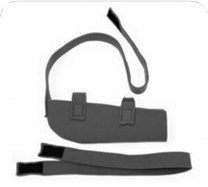
1. The polysling is made of lightweight foam. Most people find it comfortable to wear when fitted correctly. It is made up of a trough that your forearm sits in, supported by straps. It works by supporting your arm in a position to immobilise your operated shoulder (stop it moving).
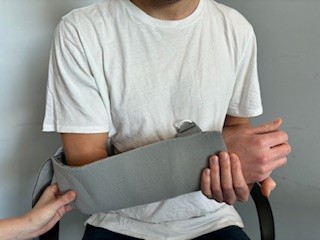
2. If someone is fitting the sling for you, support your operated arm with your elbow bent to 90 degrees (a right angle) using your unoperated arm. Slide the “trough” part of the sling in from behind so that your elbow fits snugly into the corner. See photo 2.
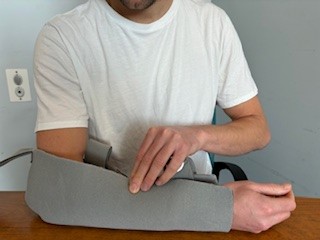
3. If you are fitting the sling without help, sit down, with your elbow bent to 90 degrees (a right angle). You will find it more comfortable if your arm is supported on a pillow. Then slide the “trough” part of the sling in from the side and ensure that your elbow fits snugly into the corner. See photo 3.
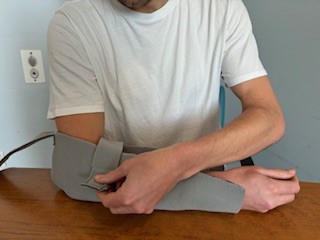
4. Fasten the strap nearest to your elbow across your forearm, it should be approximately one inch below your elbow crease. It attaches with Velcro. See photo 4.
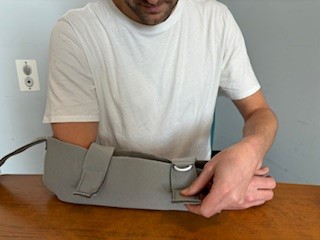
5. Attach the wrist strap approximately one inch from your wrist (towards your elbow). It attaches with Velcro. The lower ‘D’ ring should rest against your body and the upper ‘D’ ring should face upwards. See photo 5.

6. The shoulder strap is the long strap that is sewn to the “trough” part of the sling at the elbow end. Take this strap across your back and over your unoperated shoulder. See photo 6.
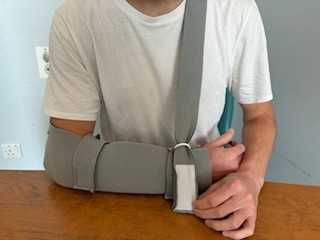
7. Feed the shoulder strap through the upper ‘D’ ring on the wrist strap. See photo 7.
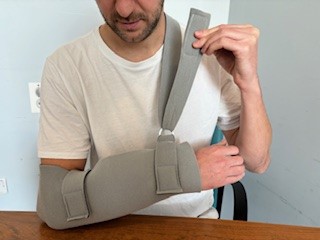
8. Attach the shoulder strap back onto itself with the Velcro. See photo 8.
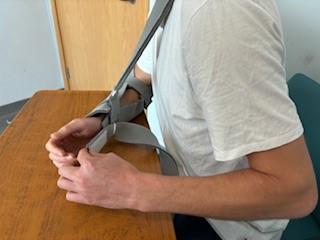
9. If you are told to wear the waist strap, feed the other long strap through the lower ‘D’ ring and attach it onto itself with the Velcro tab. See photo 9.
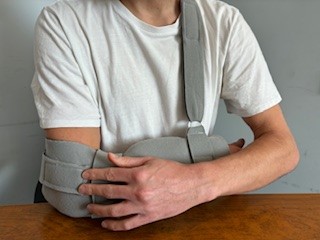
10. Take the waist strap around your back and attach it over the front of the elbow section of the sling. Adjust as necessary so that your arm is held snugly against your body. See photo 10.
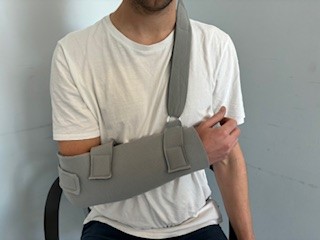
11. The final position should have your arm held close to the front of your body with your knuckles facing forwards. Your wrist should be slightly higher than your elbow to prevent any swelling in your hand. See photo 11.
You will need to be able to take your sling on and off for physio exercises and, if you are allowed, for washing and dressing.
Dressing techniques
Getting dressed if you are allowed to move your shoulder (within restrictions)
If you are told you can move your shoulder within restrictions, you can carefully dress and then put the polysling over the top of your clothes using the following method:
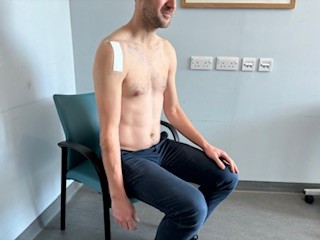
1. Remove the polysling and let your operated arm hang down to your side. You may find this easier if you sit down. See photo 12.
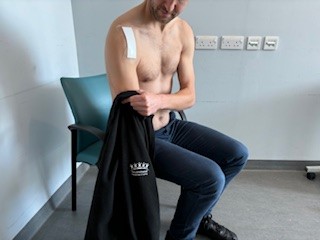
2. Using your unoperated arm feed the sleeve of the garment onto your operated arm all the way up to your armpit. See photo 13.
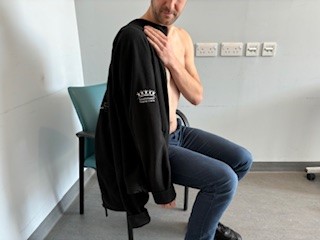
3. Do not use your operated arm to help. Your unoperated arm should do all the work. See photo 14.
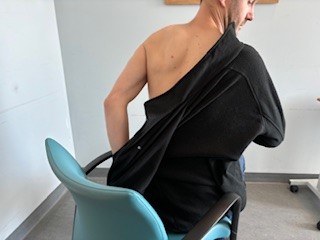
4. Next use your unoperated arm to bring the garment across your back. See photo 15.
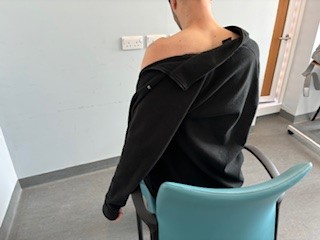
5. Put your unoperated arm into the other sleeve of the garment. See photo 16.
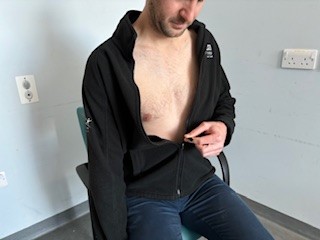
6. Use your unoperated arm to fasten the front of the garment. See photo 17. Do not use your operated arm to help as you may move your shoulder too much and cause damage to the surgery on your shoulder.
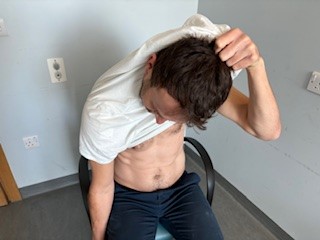
7. If the garment does not open at the front, use the method in steps 1 and 2 to feed the sleeve of the garment onto your operated arm. Then use your unoperated arm to put the garment over your head. See photo 18.
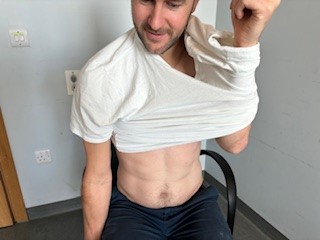
8. Put your unoperated arm into the other sleeve of the garment. See photo 19.
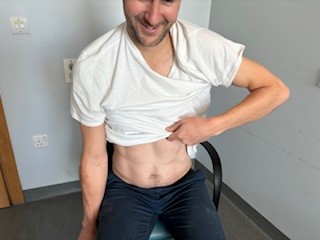
10. Use your unoperated arm to pull the garment down over your body. See photo 20.
Once you are dressed you should put the polysling back on straight away unless you have been told that the polysling is for comfort only.
To get undressed you must use the reverse of the above method: take your unoperated arm out first then slide the garment off your operated arm as it hangs to your side.
Do not move your operated shoulder or arm to help take the garment off. Your unoperated arm should do all the work.
Getting dressed if you are not allowed to move your shoulder
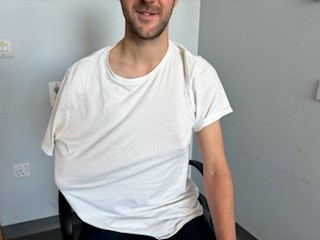
If you are told that you must not move your shoulder for a period after your surgery you must dress over the top of the sling. See photo 21.
This means you will need loose fitting clothes so that your arm will fit inside the body of the garment. If you wear a bra, you will not be able to wear one with straps as you will not be able to move your shoulder to put your arm into the straps. You may be able to feed a strapless bra under your operated arm and fasten it with help.
Suitable clothing
Try to have loose/baggy clothing available for after your surgery as dressing will be more difficult due to your shoulder restrictions. As a general rule - the looser the clothing, the easier it will be to get dressed and undressed.
Some people find that front fastening tops are easier than tops that go over the head. Choose upper and lower garments with easy fastenings. Shirts and blouses with large buttons will be easier to do up one-handed than small buttons.
Zip up cardigans or coats are very difficult to do up one handed so avoid them. Trousers or skirts with elasticated waists will be easier to manage than buttons, zips, and belts.
Wear slip-on or Velcro fastening shoes as you will not be able to fasten lace-up shoes one-handed.
Washing techniques
Washing if you are allowed to move your shoulder (within restrictions)

You can carefully remove the polysling to wash. You should keep your operated arm by your side and you can have a shower or a bath if you feel safe to do so. Your surgical wound should be covered with a shower-proof dressing but do not run the shower directly over the dressing, or soak it in the bath. Do not use your operated arm to help wash yourself as this may cause damage to the surgery on your shoulder.
You can then wash your armpit with a flannel or sponge. You can also lean forward to access your armpit to apply deodorant. See photo 22.
You may wash your hair in the shower or by leaning over a sink or bath. Do not use your operated arm to help wash your hair. Some people need assistance to wash their hair.
Washing if you are not allowed to move your shoulder at all
In some cases you may be told to keep the sling on at all times. This means washing around the polysling with a flannel or sponge. To wash your armpit of your operated side you can slide a thin flannel or a wet wipe under your armpit. Do not attempt to move your arm away from your body to get access to your armpit as this may cause damage to the surgery on your shoulder. You will not be able to apply deodorant to your armpit, but can apply it around the area (taking care to avoid your surgical wound).
To wash your hair you can lean over a sink or bath/shower whilst keeping your arm within the polysling. Take care to keep the polysling dry. Do not use your operated arm to help wash your hair. You may find that dry shampoo is a useful alternative for a short period. Some people need assistance to wash their hair.
One handed washing advice
- Use liquid soap from a dispenser if you find it difficult to handle a tablet/bar of soap.
- Use a flannel mitt with soap inside.
- A sponge lathers easier than a flannel and is easier to squeeze out after use.
Sleeping
You will need to wear your polysling to sleep in unless you are advised otherwise. The most comfortable positions for sleeping or on your back or un-operated side. Use pillows or cushions to support your operated arm and shoulder in a comfortable position.
Going to the toilet
- Wipe yourself with your un-operated arm.
- Adjust your clothing with your un-operated arm.
Cleaning your teeth
Putting toothpaste on a brush one-handed can be difficult. The following technique can be easier:
- Position the toothbrush on its back on the sink with bristles facing up. If it will not stay in position you can secure it with a piece of “blutack” or grip the toothbrush between your knees.
- Use your unoperated hand to squeeze toothpaste onto the brush.
- A pump type dispenser may be easier to use than squeezing a standard tube of toothpaste.
Kitchen activities
If you have no-one at home to help you in the kitchen try to opt for meals that will be easy to prepare one-handed.
Here are some tips:
- Ready meals can be easily put into the oven on a baking tray or into a microwave on a plate.
- Pre-prepared fresh or frozen vegetables are available in many shops to prevent the need to wash, chop, or peel vegetables.
- When cooking vegetables avoid carrying a whole pan of boiling water one-handed. Instead put the vegetables in a frying basket within a saucepan. They can then be lifted out and drained in one movement. Alternatively take the vegetables out with a slotted spoon. Once the saucepan of water has cooled it can be tipped away.
- Remember most tin openers require two hands to operate. You may need to get someone else to open tins for you or look into buying an electric one-handed tin opener.
- Scissors can be useful for opening awkward packets.
- To open jars, grip the jar between your knees and twist the lid off with your unoperated hand. If you have help from other people ask them to loosen very tight lids and transfer the contents of the jar into an easy open plastic storage container.
If you are concerned about managing kitchen activities and have no-one to help you, please ask to see the Occupational Therapist about gadgets to make life easier
Eating
You will need to eat one handed. Here are some tips:
- Eating out of a bowl may be easier than a flat plate to prevent food being pushed off the edge of the plate.
- Choose foods which are easy to cut up one-handed.
- Using a spoon may be easier than a fork.
- Put a slightly damp folded cloth under a bowl or plate to stop it sliding around the table top.
If you are concerned about eating and have no-one to help you, please ask to see the Occupational Therapist for advice.
Extra help
If you are concerned that you will not be able to manage your everyday activities and have no-one to help you, you may need a referral to Community Services for help at home.
If you are assessed as needing it, Community Services can provide assistance with washing and dressing, shopping, laundry and meals (usually from the Community Meals service). They cannot provide help with general cleaning/housework.
If you feel you need a referral for Community Services please alert the nurses or Occupational Therapist in hospital.
Caring for another person
If you are a carer for someone else and you will not be able to meet their needs after your shoulder surgery, you will need to make arrangements for their care yourself. The hospital cannot arrange help for anyone who is not a hospital inpatient.
Summary
This page should have provided you with some useful information to help you manage at home after your shoulder surgery.
If you have further questions please ask your consultant, nurse or Occupational Therapist.
Occupational Therapy Service
Southmead Hospital
Westbury-on-Trym
Bristol
BS10 5NB
© North Bristol NHS Trust. This edition published November 2024. Review due November 2027. NBT002334
